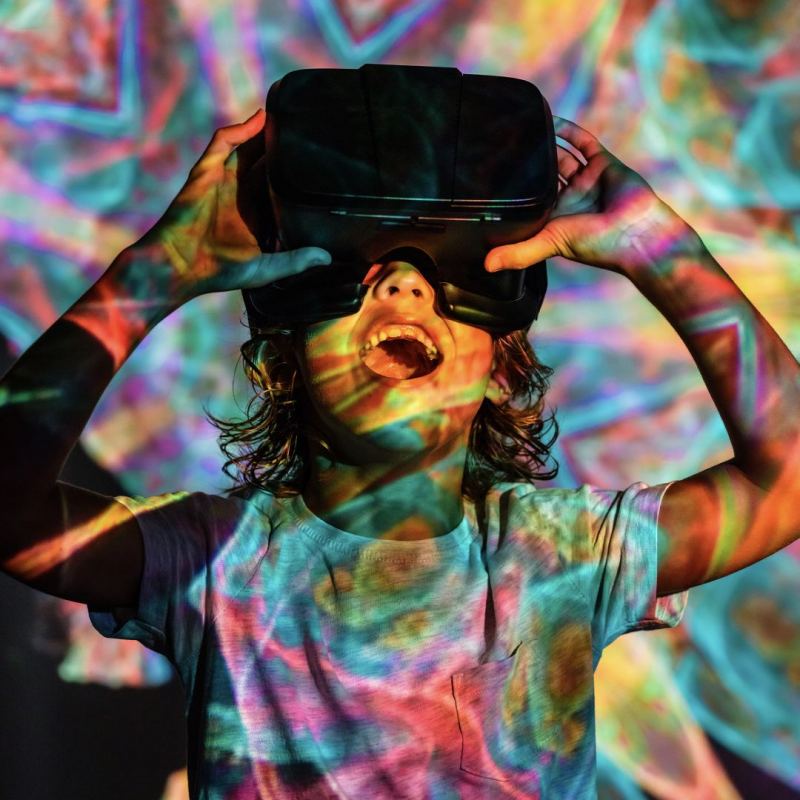Activity
Pop Up Play digital project
Pop Up Play is a free open source software product that provides creative play for children through its immersive learning environment and mixed reality system.
Use the Pop up Play system and your existing hardware to create your own unique content and immerse participants in creative play and open-ended learning.

More about this project
Pop Up Play has been developed, tested and designed for use in schools, arts venues, libraries and museums. Part theatre, part film, part game, part playground – the Pop Up Play system takes images, which can relate to children’s books, gallery or museum exhibitions, and projects them onto a screen. It is a great tool for exploration and open-ended learning. We have created a range of materials to help you plan and get the most out of your Pop Up Play experience.
The software is easy to use for several user types including artists, teachers, librarians and young people. The download comes complete with with tools, guides and support materials to get you set up.
Get started
Practitioner guide
Installation guide
Download software
FAQs
Is the digital content limited?
No, on downloading the system a broad bank of digital media will be shared. However the system has been designed so you can drag and drop in your own media content. This media content could be sourced or created by the participants.
Can I use my own film or audio footage?
Yes, follow the guidelines in the ‘Media’ section of the manual to learn how.
How much does Pop Up Play cost to download?
Pop Up Play itself is free and Open Source, however it relies on a third party component to manage the Kinect. If you wish to use the Kinect you will need to purchase a license for it for about €25. If you wish to use the iPad, then this also relies on a third party app which can be downloaded for about £35.
What size groups does Pop Up Play work well with?
Pop Up Play works best with groups of 6 – 10 undertaking the roles of Players, Directors, Constructors and Observers. Participants will naturally inter-change their roles throughout play and at times there might be 2 participants taking on each of these roles or there may be more of one role and less of others. To truly explore each role and the system, groups of 6 – 10 fit well. Also, the viewing area of the Kinect camera (which tracks the images of Player’s and projects them on screen) takes up a certain amount of space, so the smaller the room, the smaller the group. It can be difficult if you cannot get out of the view of the Kinect by sitting at the side or the back of the room. However, Pop Up Play can be used for the creation of mixed reality narrative, therefore in a larger space, you can create a sharing/performance of stories for a small audience. The Kinect itself will bring 5 or so people into the screen, but will probably only track 3 people reliably for the puppet and cutout items.
What age group is Pop Up Play aimed at?
In the research and development process, Pop Up Play was mostly tested by young people aged 6 – 11 years. This age group were able to embrace the creative play opportunities that PUP offers, immerse themselves within imaginary worlds, understand and operate the iPad controls. At the Symposium’s, PUP was tested by adult delegates who also found the system to be immense fun and therefore, although it has not been designed for adult groups, there is scope to design workshops that might benefit training and CPD for professionals. PUP has not been tested with groups of teenagers, although it has been identified that this type of digital creative play can benefit self-awareness and expression.
What abilities is Pop Up Play designed for?
Three Ways Special Education School (SEN) have been a very valued long term partner throughout the PUP research process. Young people with learning disabilities and autism spectrum disorder (ASD) explored multi-sensory workshops through Pop Up Play which proved to be hugely successful. Wheelchair users were also able to explore the system taking on each of the roles, with limited support. Although Pop Up Play has not been specifically designed for the blind/visually impaired or deaf/hearing impaired communities, the mixed reality and multi-sensory possibilities of the system may offer accessibility to digital creative play.
How long should I plan a session for?
Pop Up Play can be used to fit into an hour long class time, a two hour after school provision or full day Half Term/Summer holiday activity. Research has shown that familiarity breeds creativity rather than contempt with Pop Up Play. Groups have used the system every week for a six week period and managed to develop new ideas to keep play fresh, enough to stimulate another six weeks of work. The young people who used the system on consecutive days for a week also found that they were creatively inspired in between sessions and created new content to bring back the next day.
Can I use a Mac?
No, however we are working towards a Mac version.
Can I use a tablet other than the iPad?
Unfortunately the MIRA software will only work with an iPad at this time. We would like to offer more generic OSC controls in time which could be accessed from any tablet, but they would not offer the same level of control or visual experience. If MIRA eventually becomes available on other tablet systems then this should be possible.
Can I use a Kinect for Xbox?
The system is only for use by an end user with a ‘Kinect for Windows’ device. If you are a developer and are interested in contributing to the system, then you may be able to use the Kinect for XBOX with reference to the terms at this link.
Where is the source code?
The source code is hosted on the Github repository for the project.
Is this free and open source?
Yes, but it does use the dp.kinect/2 object which has a paid license and is covered by its own terms. If you wish to use the iPad then you will also need to buy the MIRA app.
Supported by
Pop Up Play was made possible thanks to the Digital R&D Fund (Nesta, Arts Council England, and the Arts and Humanities Research Council) in partnership with De Montfort University.

